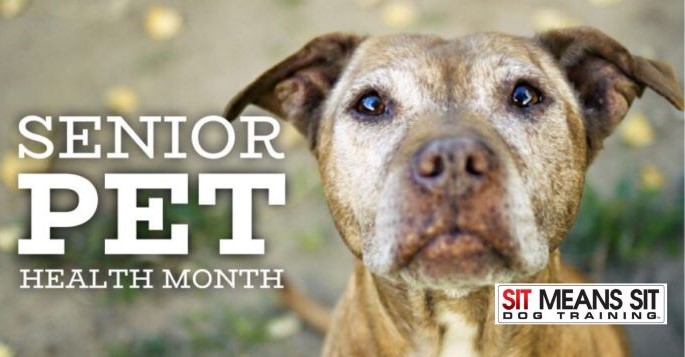
September Is Senior Pet Health Month!
Dogs’ lives are too short. Their only fault, really. – Agnes Sligh Turnbull
Everyone loves a puppy. What’s not to love? That breath, no concept of danger or fear, boops and jellybeans for days! As they grow, we grow with them. Our dogs are there for our new beginnings like graduations, weddings, and births, and even there for hard endings like breakups and the passing of our friends and family. You’ve always been there for each other, through puppy visits at the vet, working and training together, relaxing at the end of a long day. One day you look into the eyes of your best friend, and they look a little cloudier than they did the day before. Maybe you both take a little longer to get off of the sofa and prefer lounging in the sunshine just to feel the warmth of the rays deep in your bones. Maybe you see the grey in his muzzle coming on more quickly than the grey in your beard.
It’s said that dogs age a rate that is nearly seven times that of humans. Just like our health changes as we age, our pups will experience a shift in their own well-being, and even the most loving and attentive owner can miss signs by assuming that deviations in their dog’s patterns are normal, merely due to age. It is far better to err on the side of caution and contact your veterinarian when you have any doubts. To help, here is a list of common health problems commonly seen in aging dogs.
- ARTHRITIS – Arthritis occurs when the cartilage that cushions joints begins to deteriorate, causing inflammation of the joint. Treatment can include, but is not limited to, changes in diet and exercise or medications. Dogs can exhibit many different signs when they have arthritis, and they do not necessarily demonstrate all the same signs all the time. The most common signs dog owners may notice include difficulty getting up and down, lameness, stiff gait, or excessive licking of a joint.
- DIABETES – Read more about canine diabetes here.
- LOSS OF VISION – While poor vision can have many medical explanations, it is most often caused by cataracts. Inside the eye is a lens that focuses light on the back of the eye or the retina. Vision occurs at the retina. The structure of the eye is similar to a camera, which has a lens to focus light on the film. A cloudy or opaque lens is called a cataract. The most common cause of cataracts in the dog is inherited disease. Some cataracts appear to occur spontaneously and are age related.
- DENTAL DISEASE – Read more about dental disease here.
- CHANGES IN BEHAVIOR – Senior dogs with no prior history of behavior issues may begin to exhibit signs of underlying medical issues through the development of bad behaviors. Aggression to other dogs or people can indicate a thyroid imbalance. Dementia may be indicated by anxiety and routine disruption as their mental health begins to deteriorate. Other behaviors that may seem unrelated can forecast conditions that require veterinary intervention.
Because senior dogs are more likely to develop age-related problems, they should be regularly examined by a veterinarian to keep them healthy and to detect problems before they become more difficult and costly to treat. Talk to your vet about a preventive care schedule that best suits your dog. With the right combination of preventative care and education, you can help ensure that you and your dog will have more time to share each other’s company and enjoy those the little things that truly make him your best friend.
